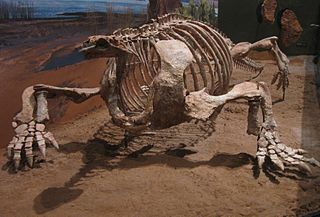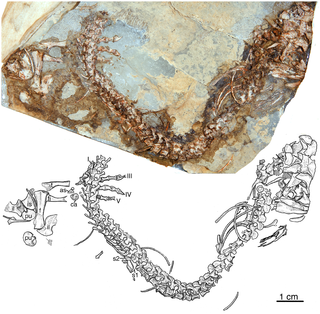
Dissorophidae is an extinct family of medium-sized, temnospondyl amphibians that flourished during the late Carboniferous and early Permian periods. The clade is known almost exclusively from North America.

Caseasauria is one of the two main clades of early synapsids, the other being the Eupelycosauria. Caseasaurs are currently known only from the Late Carboniferous and the Permian, and include two superficially different families, the small insectivorous or carnivorous Eothyrididae, and the large, herbivorous Caseidae. These two groups share a number of specialised features associated with the morphology of the snout and external naris.
Casea is an extinct genus of medium to large-bodied, herbivorous, pelycosaur synapsids from the late Carboniferous until the middle Permian. The name Casea references its appearance from the Caseasauria which developed new morphology of their external naris and snout. Casea were known to be about 1.2 meters long. It weighed between 150 kg to 200 kg. It was slightly smaller than the otherwise very similar Caseoides. Casea was one of the first amniote herbivores, sharing its world with animals such as Dimetrodon and Eryops. It was possibly also aquatic.

Cotylorhynchus is an extinct genus of very large synapsids that lived in the southern part of what is now North America during the Early Permian period. It is the best known member of the synapsid clade Caseidae, usually considered the largest terrestrial vertebrates of the Early Permian, though they were possibly aquatic.

Ennatosaurus was a synapsid that lived in European Russia during the Wordian stage of the Permian period. It is included in the synapsid clade Caseidae in the order Pelycosauria.

Aerosaurus is an extinct genus within Varanopidae, a family of non-mammalian synapsids. It lived between 252-299 million years ago during the Early Permian in North America. The name comes from Latin aes (aeris) “copper” and Greek sauros “lizard,” for El Cobre Canyon in northern New Mexico, where the type fossil was found and the site of former copper mines. Aerosaurus was a small to medium-bodied carnivorous synapsid characterized by its recurved teeth, triangular lateral temporal fenestra, and extended teeth row. Two species are recognized: A. greenleeorum (1937) and A. wellesi (1981).
Eosyodon is a dubious genus of extinct non-mammalian synapsids from the Permian of Texas. Its type and only species is Eosyodon hudsoni. Though it was originally interpreted as an early therapsid, it is probably a member of Sphenacodontidae, the family of synapsids that includes Dimetrodon.
Elliotsmithia is a small varanopid synapsid found from the late Middle Permian of South Africa. It is the sole basal synapsid "pelycosaur" known from the supercontinent Gondwana and only two specimens have been yielded to date. Its species name longiceps is derived from Latin, meaning "long head". Both known Elliotsmithia fossils were recovered from Abrahamskraal Formation rocks—within the boundaries of the Tapinocephalus Assemblage Zone—of the lower Beaufort Group.
Oromycter is an extinct genus of caseid synapsids from the Early Permian of Oklahoma. The sole and type species, Oromycter dolesorum, was named in 2005 by Robert R. Reisz.

Tetragonias is an extinct genus of non-mammalian synapsid from the Anisian Manda Beds of Tanzania. Tetra- means “four,” and goni- means “angle,” referencing the square shape of the Tetragonias skull when viewed dorsally. Not to be confused with Tetragonia,Tetragonias were dicynodont anomodonts discovered in the late 1960s by paleontologist A. R. I. Cruickshank in the Manda Formation.
Watongia is an extinct genus of non-mammalian synapsids from Middle Permian of Oklahoma. Only one species has been described, Watongia meieri, from the Chickasha Formation. It was assigned to family Gorgonopsidae by Olson and to Eotitanosuchia by Carroll. Reisz and collaborators assigned the genus in Varanopidae.

Raranimus is an extinct genus of therapsids of the Middle Permian. It was described in 2009 from a partial skull found in 1998 from the Dashankou locality of the Xidagou Formation, outcropping in the Qilian Mountains of Gansu, China. The genus is the most basal known member of the clade Therapsida, to which the later Mammalia belong.
Olson's Extinction was a mass extinction that occurred 273 million years ago in the early Guadalupian of the Permian period and which predated the Permian–Triassic extinction event. It is named after Everett C. Olson. There was a hiatus and a sudden change in between the early Permian and middle/late Permian faunas. Since then this event has been realized across many groups, including plants, marine invertebrates, and tetrapods.

Euromycter is an extinct genus of medium-sized caseid synapsids from Early (Artinskian-Kungurian) or Middle (Roadian-Wordian) Permian deposits of Southern France. The holotype and only known specimen of Euromycter (MNHN.F.MCL-2) includes the complete skull with lower jaws and hyoid apparatus, six cervical vertebrae with proatlas, anterior part of interclavicle, partial right clavicle, right posterior coracoid, distal head of right humerus, left and right radius, left and right ulna, and complete left manus. It was collected by D. Sigogneau-Russell and D. Russell in 1970 at the top of the M1 Member, Grès Rouge Group, near the village of Valady, Rodez Basin. It was first assigned to the species "Casea" rutena by Sigogneau-Russell and Russell in 1974. More recently, it was reassigned to its own genus, Euromycter, by Robert R. Reisz, Hillary C. Maddin, Jörg Fröbisch and Jocelyn Falconnet in 2011. The preserved part of the skeleton suggests a size between 1,70 m (5,5 ft) and 1,80 m (5,9 ft) in length for this individual.
Gorgodon is an extinct genus of basal synapsids. The genus is monotypic, known only from the type species Gorgodon minutus from the Early Permian of the southwestern United States. The only known remains of Gorgodon are two fossils consisting of fragments of the skull. Gorgodon was described and named by paleontologist Everett C. Olson in 1962 from the San Angelo Formation in Knox County, Texas. Based on what is known of Gorgodon—the squamosal, quadrate, and pterygoid bones of the back of the skull, the maxilla and premaxilla bones that make up the front of the skull, and several teeth—Gorgodon had a relatively large temporal fenestra and a pair large, conical caniniform teeth at the front of the jaw. Other distinguishing features of Gorgodon include the fused connection between the quadrate and squamosal bones and a long transverse process of the pterygoid.

Eocasea is an extinct genus of caseid synapsids from the Late Pennsylvanian of Kansas. It is known from a single type species, Eocasea martini.
The San Angelo Formation is a geologic formation in Texas. It preserves fossils dating back to the Permian period. It is one of the geologically youngest formations to preserve fossils of pelycosaurs.
Parasumina is an extinct genus of anomodont known from the late Capitanian age at the end of the middle Permian period of European Russia. The type and only species is Parasuminia ivakhnekoi. It was closely related to Suminia, another Russian anomodont, and was named for its resemblance. Little is known about Parasuminia as the only fossils are of fragmentary pieces of the skull and jaw, but the known remains suggest that its head and jaws were deeper and more robust than those of Suminia, and with shorter, stouter teeth. However, despite these differences they appear to have been similar animals with a similarly complex method of processing vegetation.
Hillary Catherine Maddin is a Canadian paleontologist and developmental biologist known for her work on development in extinct and extant amphibians. She is currently an associate professor in the Department of Earth Sciences at Carleton University.















